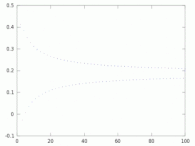The MRB constant is a mathematical constant, with decimal expansion 0.187859… (sequence A037077 in the OEIS). The constant is named after its discoverer, Marvin Ray Burns, who published his discovery of the constant in 1999.[1] Burns had initially called the constant "rc" for root constant[2] but, at Simon Plouffe's suggestion, the constant was renamed the 'Marvin Ray Burns's Constant', or "MRB constant".[3]

The MRB constant is defined as the upper limit of the partial sums[4][5][6][7][8][9][10]
As grows to infinity, the sums have upper and lower limit points of −0.812140… and 0.187859…, separated by an interval of length 1. The constant can also be explicitly defined by the following infinite sums:[4]
The constant relates to the divergent series:
There is no known closed-form expression of the MRB constant,[11] nor is it known whether the MRB constant is algebraic, transcendental or even irrational.
References
edit- ^ Plouffe, Simon. "mrburns". Retrieved 12 January 2015.
- ^ Burns, Marvin R. (23 January 1999). "RC". math2.org. Retrieved 5 May 2009.
- ^ Plouffe, Simon (20 November 1999). "Tables of Constants" (PDF). Laboratoire de combinatoire et d'informatique mathématique. Retrieved 5 May 2009.
- ^ a b Weisstein, Eric W. "MRB Constant". MathWorld.
- ^ Mathar, Richard J. (2009). "Numerical Evaluation of the Oscillatory Integral Over exp(iπx) x^*1/x) Between 1 and Infinity". arXiv:0912.3844 [math.CA].
- ^ Crandall, Richard. "Unified algorithms for polylogarithm, L-series, and zeta variants" (PDF). PSI Press. Archived from the original on April 30, 2013. Retrieved 16 January 2015.
- ^ (sequence A037077 in the OEIS)
- ^ (sequence A160755 in the OEIS)
- ^ (sequence A173273 in the OEIS)
- ^ Fiorentini, Mauro. "MRB (costante)". bitman.name (in Italian). Retrieved 14 January 2015.
- ^ Finch, Steven R. (2003). Mathematical Constants. Cambridge, England: Cambridge University Press. p. 450. ISBN 0-521-81805-2.




